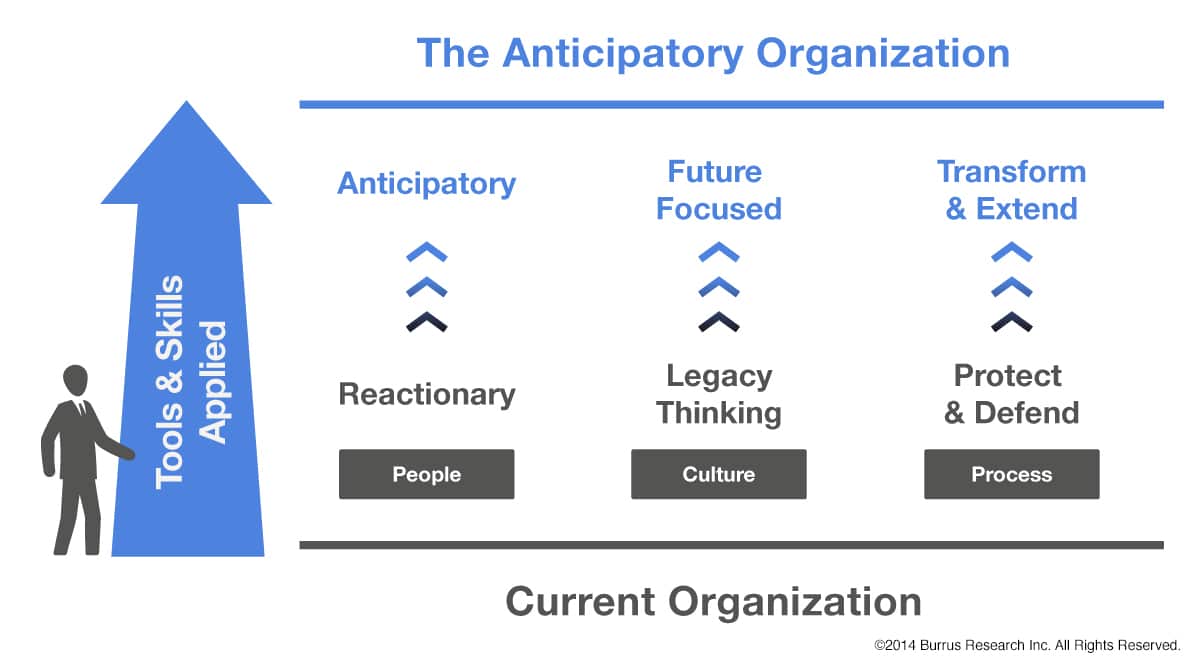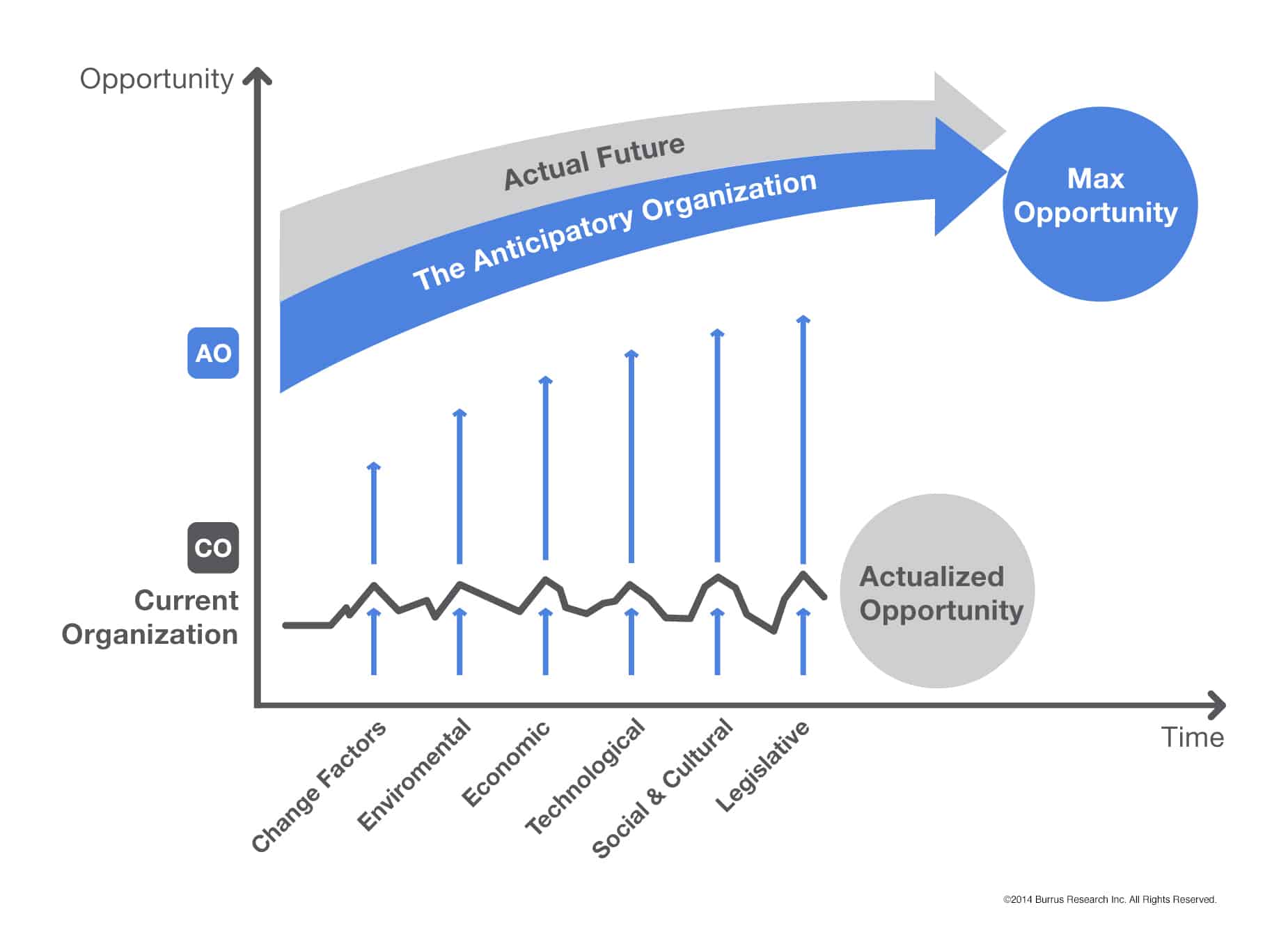Anticipatory Associations: Using Hard Trends to Turn Disruption into Opportunities

All associations develop strategic plans based on trends identified by their leaders. There’s no shortage of trends, and as every new year begins, there are many trend lists published for the upcoming year. One of the big problems associations face is deciding which trends will happen and which ones won’t.
In addition, associations depend on meetings as a major source of member benefits, growth, and revenue, and when the world of meetings is disrupted, as it was after 9/11, the recession of 2008-2009, and most recently COVID, the industry as a whole was turned upside down.
Agility helped, but the world is changing faster than we can react to it. A key strategy going forward is not only being agile (in other words, reacting as quickly as possible to a disruption or problem) — it’s even more important to learn to be anticipatory. Anticipate disruptions before they disrupt and anticipate problems before you have them so those problems can be pre-solved.
Anticipatory Associations

Illustration courtesy of Burrus Research Inc.
There are two key points I need to make to help association leaders more accurately plan for, and more importantly take advantage of, disruption and change. The first is based on 40 years of research: All trends can be put into one of two main categories. They are either Hard Trends that will happen, or Soft Trends that might happen. More on that in a minute.
The second key point is that a trend by itself is academic, with little future value. By attaching an actionable opportunity to each Hard Trend or Soft Trend, the trend will burst into actionable life.
Hard Trends
A Hard Trend is based on a future fact that will happen, a future certainty. It is something we know is going to occur whether we want it to or not. From a planning and innovation standpoint, strategies based on uncertainty come with high levels of risk, but strategies based on certainty dramatically reduce risk and often produce superior results.
In addition, when people are uncertain, they hesitate, they don’t say yes and they don’t write big checks. Instead, they develop a wait-and-see attitude, which is very dangerous in a world of technology-driven exponential change. On the other hand, when people have high levels of certainty, they have the confidence to make bold moves, to say yes and to write big checks.
A few quick examples include the future facts that many members will be retiring over the next five years and potential new younger members will have different expectations and needs. An example of a related opportunity would be to talk to younger members and potential members and find out what they would want from their association that would make it a priority to join and contribute to.
Another quick example of a Hard Trend is that meetings going forward will be a mix of in-person, virtual and hybrid. Virtual is not going away.

Illustration courtesy of Burrus Research Inc.
Part of our challenge with figuring out what the future will bring is our human default to think about new things with an “either/or” mindset: Either it’s going to be live in-person or virtual; either it’s going to be working from home or at the office; either it’s going to be all the vendors on the show floor with their hardware or it’s going to be all virtual reality. I attribute much of my ability to forecast with accuracy over nearly four decades to embracing what I call the “both/and” concept.
Here’s how that concept works for associations and their events. The future is in-person events — of course we want to be with other people; we’re human beings. But on the other hand, the virtual element, the hybrid element — oh, that’s there, too. There are certain meetings that would serve us well to just be virtual — there are things you can do in the digital world that you can’t do in the physical world. There are things you can do in the physical world that you can’t do in the virtual world. It’s important for us to think through what those things are. So, if we are having a physical meeting and we do things that actually could have been done better as a virtual meeting, then why would we have the physical meeting? And if we’re in-person, we should be maximizing the fact that we’re physically getting together. It’s important to embrace both delivery channels.
As a keynote speaker, I have given more than 3,000 in-person speeches — a few with audiences over 14,000 — and there is a magic collaborative energy that happens when humans are together with each other. They build relationships at a deeper level, not to mention buying and selling to each other.
On the other hand, I have given several hundred virtual speeches during the past few years, some in Asia and some in Europe, all in the same day. In addition, the largest virtual audience that was logged in to one of my presentations was a little over 1.1 million. Both examples would be impossible for me to do if they were in-person events.
Virtual has unique advantages in-person can’t duplicate. Virtual is here to stay.
I know many meeting planners who have grown to hate virtual meetings and would like all meetings going forward to be in-person only. Instead of hating virtual meetings, let’s use the certainty that comes from Hard Trends to embrace and extend and transform virtual meetings. Identify tools and develop strategies to make virtual meetings an even better member experience. I suggest seeking out tools and systems to make planning both all-virtual and hybrid meetings less difficult, less time-consuming, and less expensive — to explore how you can increase revenue and have the virtual component of a physical meeting be a profit instead of a cost to the association. I know some are already doing this, so let’s learn from each other.

Soft Trends
Opposite of Hard Trends are Soft Trends, which are based on assumptions that may or may not take place, a future possibility. In the case of Soft Trends, they can be changed to you and your association’s benefit. I’ll share some Soft Trend examples as I cover both below.
More on Hard Trends
To further explore my Hard Trend Methodology and how it can help you be more anticipatory during times like we currently face, I have grouped Hard Trends into three primary categories for identification purposes.
Demographics. This can be age, race, gender, or any other defining characteristic of a group. For example, there will be an increasing number of Baby Boomers retiring, and this will have a predictable impact on associations. Here is where separating Hard Trends and Soft Trends can help. As board members, past presidents and active participants retire, they will take their knowledge and wisdom with them. This statement has both types of trends, and actionable opportunities!
Hard Trend. The group mentioned above will increasingly be retiring. Soft Trend: They will take their knowledge and wisdom with them. That is not a future fact! Associations can do something about this before it happens by setting up mentoring programs and creating a knowledge base based on their past insights and experiences.
Government Regulations and Oversight. As new technological innovations occur, transforming entire industries, and new problems such as new levels of cyber security risk emerge, we will continue to have new regulations. Instead of looking at all the things we don’t like about new regulations, look for new opportunities. For example, there are amazing funding opportunities in all regulations, and associations can take advantage of many.
Technology. We went from 4G wireless to 5G — is that it? No, the Hard Trend is that following 5G will be 6G and then 7G. Will AI continue to grow at exponential levels? Yes! The key is looking for ways to use 5G or AI or any number of new technology tools to plan meetings and new services for members.
On the near horizon, we will see virtual augmented reality glasses that look like normal glasses from companies like Apple and Samsung where you can view an overlay of data with your voice or by touching the earpiece of your glasses. What kind of data might I see? Well, I could easily see me touching the earpiece of my AR glasses and being able to see the names of all the people who are sitting in the audience. That application does not currently exist — you can’t buy that technology today — but would you say that will never happen? I think you realize it’s a Hard Trend, because when it comes to technology, if it can be done, it will be done. And if you don’t do it, someone else will. When it comes to applying technology to make the impossible possible, humans are great at doing just that.
For a trade show where exhibitors bring heavy equipment to the show floor, in the near future, attendees, using a virtual reality headset, will be able to see and maneuver heavy equipment that is not physically on the show floor. Does that mean people won’t have to bring anything to demonstrate at convention centers? No, not at all. It means that vendors can show more than they could fit in the physical environment. This is another great example demonstrating the “Both/And” concept.
From the ever-increasing accessibility of holographic telepresence and the metaverse, technology is inevitably going to become more functional, more sophisticated, and more widespread, not to mention less expensive. We will always be finding a newer, better way to accomplish a task or create something.

Illustration courtesy of Burrus Research Inc.
Why Hard Trends Matter
Knowing that something is a future certainty means so much more in times like these. It’s central to your association’s planning and subsequent execution of innovation, even during a slowdown or recession.
Leveraging Hard Trends to your advantage is how you can also pre-solve problems before they exist. Case in point: When the United States government mandated a stay-at-home order, closing the physical operations of many nonessential businesses, many threw up their hands in frustration, while others decided to adapt and overcome, taking advantage of opportunities to continue to operate during a shutdown – and profited accordingly.
For example, the Maryland Association of CPAs had everyone on staff go through my Anticipatory Organization Learning System years before the pandemic struck, so when the pandemic lockdown happened in March 2020, they anticipated the government would be making a decision about the profession of accounting. Instead of waiting to see if accounting would be considered essential, the head of their association, Tom Hood, made the pitch to government that accounting needed to be classified as essential, and that happened.
If all you see now — given airline delays and cancellations, supply chain issues and inflation, to name a few — is crisis, I’m afraid you’re not going to see the big opportunities you can take advantage of. There have never been more opportunities for associations and event planners to redefine their customer experience than there are today.
What you can expect is that Hard Trends — identified and acted upon — can offer enormous opportunities for those associations and organizations with the mindset of always keeping their opportunity antennas up and using both Hard Trend and Soft Trend opportunities to share the future today!
Tags
Related Articles
Great Bosses, Greater Impact: Leadership Lessons that Stick
The best bosses leave more than instructions—they leave echoes of confidence, creativity, and leadership that...
4 Key Strengths of an Association’s Board
A 2023 study asked association leaders which strengths are vital to a board. Read what...
CEO Perspectives on Association Forum’s Governance Professional Practice Statments
Association Forum members have access to professional practice statements. A committee reviews these statements annually....





